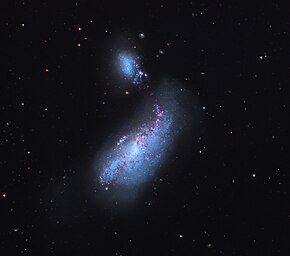| NGC 4490 | |
|---|---|
 NGC 4490 and satellite galaxy, NGC 4485 | |
| Observation data (J2000 epoch) | |
| Constellation | Canes Venatici |
| Right ascension | 12h 30m 36.2s[1] |
| Declination | 41° 38′ 38″[1] |
| Redshift | 565 ± 3 km/s[1] |
| Distance | 25.1 ± 5.0 Mly (7.7 ± 1.5 Mpc)[1] |
| Apparent magnitude (V) | 9.8 |
| Characteristics | |
| Type | SB(s)d pec [1] |
| Size | 53000 ly |
| Apparent size (V) | 6.3′ × 3.1′[1] |
| Other designations | |
| Arp 269, UGC 7651, PGC 41333[1] | |
NGC 4490, also known as the Cocoon Galaxy, is a barred spiral galaxy in the constellation Canes Venatici. William Herschel discovered it in 1788. It is known to be of the closest interacting/merging galactic system. The galaxy lies at a distance of 25 million light years from Earth making it located in the local universe. It interacts with its smaller companion NGC 4485 and as a result is a starburst galaxy. NGC 4490 and NGC 4485 are collectively known in the Atlas of Peculiar Galaxies as Arp 269. The two galaxies has already made their closest approach and are rushing away from each other. It's been discovered that NGC 4490 has a double nucleus.[2]
NGC 4490 is located 3/4° northwest of beta Canum Venaticorum and with apparent visual magnitude 9.8, can be observed with 15x100 binoculars.[3] It is a member of the Herschel 400 Catalogue. It belongs to the Canes II Group. NGC 4490 has a system of satellite galaxies oriented roughly in a plane.[4]
- ^ a b c d e f g "NASA/IPAC Extragalactic Database". Results for NGC 4490. Retrieved 2016-01-18.
- ^ Lawrence, A. L.; Kerton, C. R.; Struck, Curtis; Smith, Beverly J. (2020-02-27). "Revealing the Double Nucleus of NGC 4490". The Astrophysical Journal. 891 (1): 11. arXiv:2001.05601. Bibcode:2020ApJ...891...11L. doi:10.3847/1538-4357/ab6c6a. ISSN 1538-4357.
- ^ Craig Crossen, Gerald Rhemann (2012). Sky Vistas: Astronomy for Binoculars and Richest-Field Telescopes. Springer Science+Business Media. p. 233. ISBN 978-3-7091-0626-6.
- ^ Pawlowski, Marcel S.; Müller, Oliver; Taibi, Salvatore; Júlio, Mariana P.; Kanehisa, Kosuke Jamie; Heesters, Nick (2024). "The satellite galaxy plane of NGC 4490 in light of ΛCDM". Astronomy & Astrophysics. 688: A153. arXiv:2405.06016. Bibcode:2024A&A...688A.153P. doi:10.1051/0004-6361/202449954.